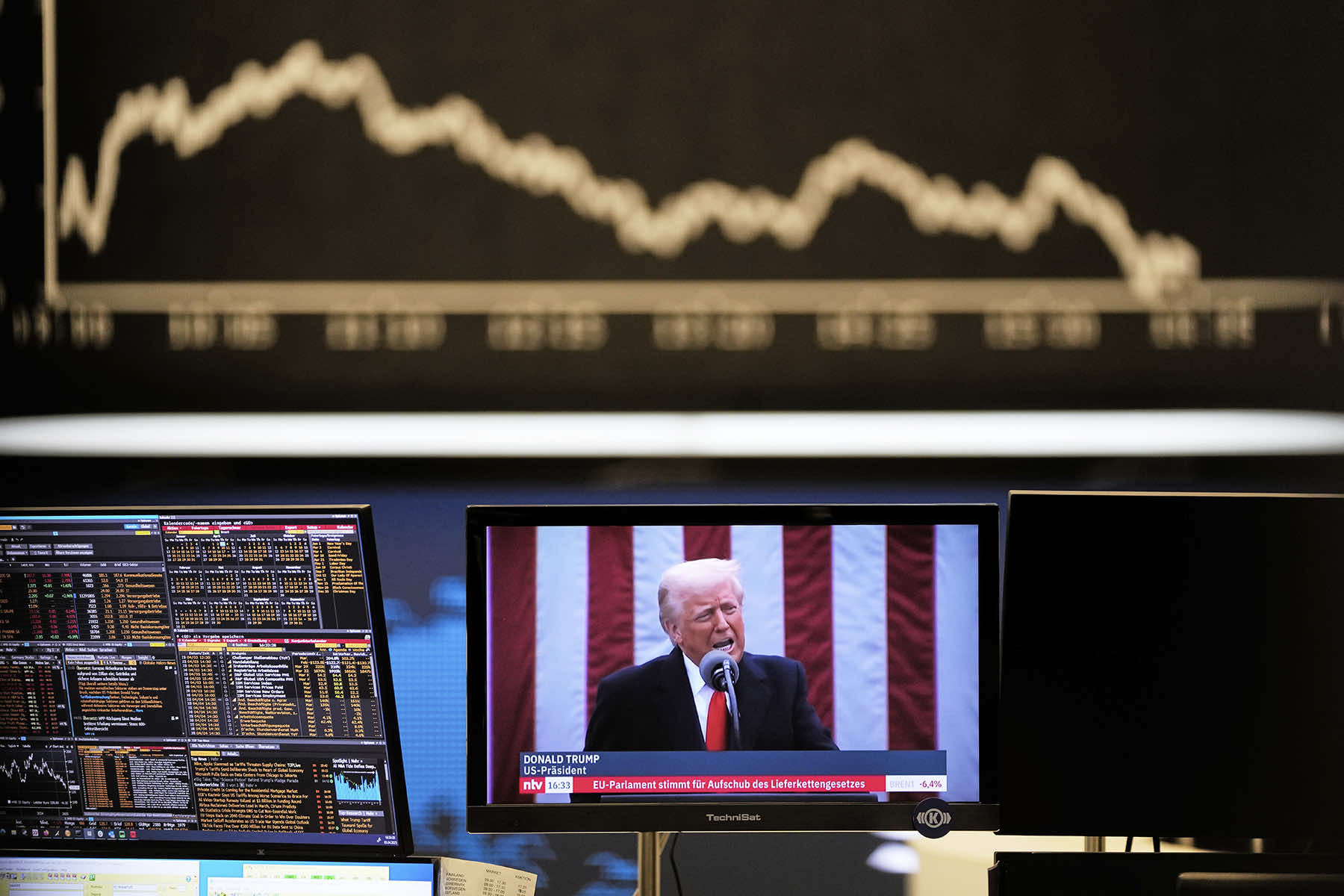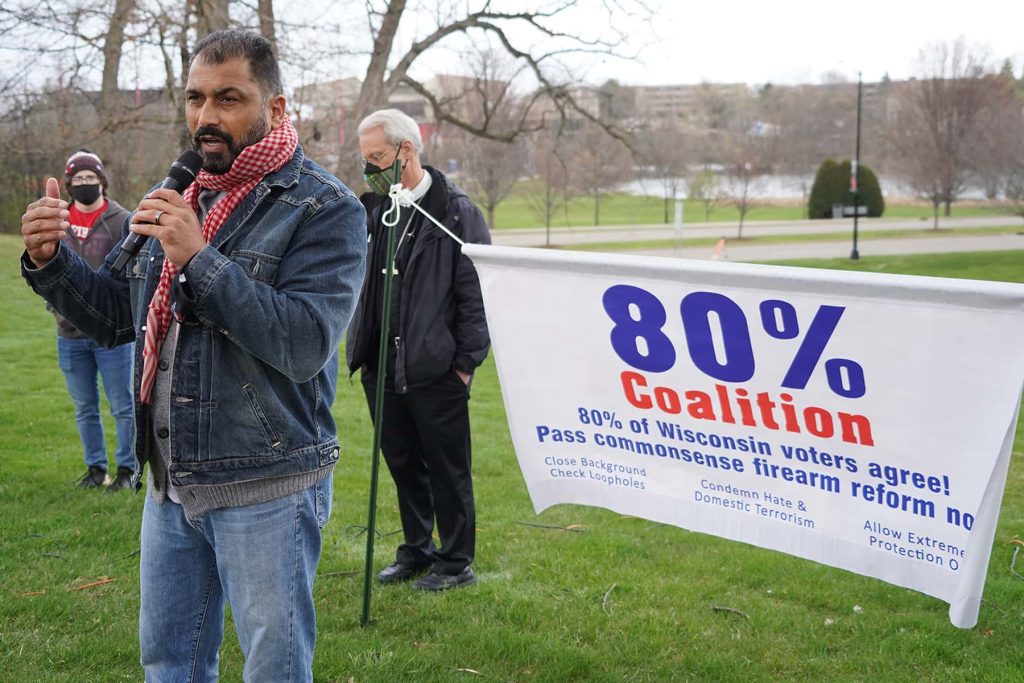
Donald Trump stood in the Rose Garden on April 2 and declared “Liberation Day,” unveiling a sweeping set of unilateral tariffs that triggered immediate economic aftershocks across global markets.
While the Trump regime frames the policy as a patriotic assertion of sovereignty, early indicators suggest a destabilizing move with characteristics of economic coercion and broad civilian fallout, a combination that some analysts argue resembles the hallmarks of “economic terrorism.”
The tariffs, enacted by executive order, apply a flat 10% duty on all imports to the United States, with higher rates targeting key trading partners beginning later in April. The White House described the move as necessary to “restore American industrial independence,” though no prior consultation with Congress, industry groups, or allied governments was conducted. The announcement took effect without public economic modeling or emergency safeguards for affected sectors.
“Dow drops nearly 1,680 in biggest wipeout since 2020: The S&P 500 fell 4.8% Thursday, more than other major stock markets. The Dow Jones Industrial Average dropped 1,679 points, and the Nasdaq composite sank 6%.” – Associated Press (April 4, 2025)
Within 48 hours, global financial systems reacted sharply. Major U.S. stock indices closed down by more than 4% on April 3, and the volatility spread to Asia and Europe. The Nikkei index dropped over 3.5%, while Germany’s DAX fell nearly 5%. Commodity futures, particularly agricultural and energy-linked, spiked amid fears of retaliatory tariffs from China, the EU, and other nations caught in the crossfire.
The White House did not provide advance notice to U.S. trade partners or domestic producers. A spokesperson for the Office of the U.S. Trade Representative declined to release internal briefing materials or forecasts, claiming only that the president was acting under “broad emergency powers granted under Section 301 and the International Emergency Economic Powers Act.”
While the legal mechanism is real, experts argue the speed and scale of implementation suggest an intent beyond simple trade recalibration.
Among those most immediately affected: shipping operators, retailers, and commodity suppliers. In Long Beach, California, port scheduling authorities confirmed multiple container ships were held offshore pending clarification on customs processing under the new tariff schedule. In Texas, a regional produce distributor reported losing a multi-million-dollar shipment due to unclear enforcement protocols at the border.
In Milwaukee, a historic center of industrial production, the tariffs have already strained critical sectors ranging from metal fabrication to beverage packaging. Wisconsin’s economy relies heavily on imported materials like German machine parts, Canadian steel, and aluminum for its advanced manufacturing base. With no exemptions issued by the Trump regime, many Wisconsin-based firms are facing sudden price hikes on core components essential to maintaining operations.
The Wisconsin Manufacturers & Commerce Association issued a statement on April 3 warning that small and midsize manufacturers were “exposed to major cost shocks due to the flat tariff structure and lack of transition safeguards.” Dairy processors — a pillar of the state’s economy — are also anticipating export retaliation, with key markets in Canada and China now under review. Wisconsin exported more than $23 billion in goods last year, much of it now threatened by global blowback.
Milwaukee officials have begun assessing the potential for layoffs and production slowdowns. Economic development officers expressed alarm at the lack of federal guidance or carve-outs for essential sectors.
“There’s no question we’re bracing for economic dislocation,” said Angela Mendoza, spokesperson for the Milwaukee Economic Development Corporation. “We have not received communication from the Trump regime on relief mechanisms for impacted cities like ours.”
Milwaukee’s vulnerability to tariff shock is rooted in a longer arc of corporate abandonment. In the 1970s, American manufacturers began aggressively offshoring production to cut labor costs, evade domestic regulation, and chase global tax arbitrage.
Cities like Milwaukee — once strongholds of steel, machinery, and unionized labor — were gutted by a wave of capital flight justified as a competitive necessity. From A.O. Smith to Allis-Chalmers, iconic firms either shuttered plants or shifted supply chains abroad. The damage was structural: lost wages, depopulated neighborhoods, and weakened industrial resilience.
Today, with foreign inputs embedded across even small manufacturers’ workflows, the city is exposed again — not by globalization this time, but by its abrupt unraveling. The same corporate logics that outsourced Milwaukee’s industrial future are now being reversed at gunpoint, with no cushion or consent. It is a rerun of economic violence, reframed as policy.
International allies responded with unease. Canadian Finance Minister Isabelle Fournier described the tariffs as “an unprovoked disruption of essential trade flows.” In Brussels, the European Commission announced it would begin emergency consultations under WTO protocols. China’s Ministry of Commerce issued a brief statement condemning the action and pledged “proportional countermeasures.”
Of the nearly 190 countries engaged in global trade, only one emerged untouched by Trump’s economic purge: Russia. While longtime allies were hammered with tariffs, and trading partners from Asia to Europe were thrown into chaos, Vladimir Putin’s brutally oppressive regime was granted a silent pass. No penalties. No restrictions. No explanation.
This omission is not a bureaucratic oversight, it is a clear political signal. A regime that interfered in U.S. elections, destabilized Europe, and invaded the sovereign nation of Ukraine without provocation was exempted from the most sweeping American trade crackdown in modern history. It is not just hypocrisy, it is alignment. The White House punished the global order and protected the Kremlin — and in that choice, revealed the true coordinates of its economic war.
Yet, the Trump regime still maintains that the tariffs are short-term disruptions that will produce long-term gains. Trump, speaking at the unveiling he said, “For decades, our country has been looted, pillaged, raped, and plundered by nations near and far, both friend and foe alike. American steelworkers, auto workers, farmers, and skilled craftsmen. They really suffered gravely. They watched in anguish as foreign leaders have stolen our jobs, foreign cheaters have ransacked our factories, and foreign scavengers have torn apart our once beautiful American dream.”
Critics warn that any so-called “short-term” consequences are already profound. Inflation projections rose overnight, with supply chain analysts forecasting up to a 20% price increase in key categories such as electronics, appliances, and industrial machinery. Economists at the Peterson Institute for International Economics warned of a sharp consumer spending contraction if downstream costs reach retailers before summer.
For all its handwringing, the Republican-controlled Congress is not a bystander to this crisis. It is a willing accomplice. With full knowledge of the consequences, GOP leadership has chosen to shield the administration rather than confront the economic devastation unleashed by the tariffs.
There have been no emergency hearings, no binding resolutions, no meaningful oversight. Their silence is not passivity, it is political alignment with a doctrine of economic warfare. By abandoning even the pretense of legislative restraint, congressional Republicans have surrendered their authority and made themselves co-authors of this disaster. They have traded governance for obedience, and it only cost the nation closed factories, broken trade alliances, and the financial ruin of millions.
The comparison of Trump’s tariffs to “economic terrorism,” a term with no formal legal definition but used in global policy discourse, is beginning to surface in policy analysis and media commentary. In this framing, the defining traits are intentional disruption of economic stability, broad civilian harm, and coercive policy aims.
The definition of economic terrorism, in this context, refers to the deliberate use of state economic power to destabilize markets, inflict civilian hardship, and exert political pressure without military engagement. It is not an academic abstraction or rhetorical flourish, it describes a pattern of intentional, disproportionate disruption designed to cause financial suffering, provoke retaliation, and collapse cooperative structures.
When policies are deployed not to solve economic problems but to manufacture a crisis for strategic gain, they cease to be governance and enter the territory of coercion. This is not a trade policy. It is a doctrine of economic violence.
In the days following the April 2 announcement, leading economists warned that the tariffs would inflict rapid downstream damage to global supply chains already under strain. A report from the Peterson Institute for International Economics on April 3 stated the policy “could trigger price instability in consumer categories tied to precision manufacturing, imported electronics, and intermediate goods for U.S. factories.”
The group estimated the tariffs could cost American households an average of $1,350 annually if fully passed through to end-users. “There is no evidence of strategic targeting,” the report stated. “The flat structure appears deliberately punitive and indiscriminate.”
The lack of targeting has also alarmed humanitarian and development organizations. Several NGOs have warned that retaliatory trade disruptions could jeopardize food and medicine supply chains in lower-income regions dependent on transatlantic logistics and U.S.-based pharmaceuticals. The tariffs also apply to medical equipment and diagnostic technologies, which saw dramatic cross-border demand spikes during the COVID-19 pandemic.
As of April 4, the World Trade Organization had not issued a formal ruling, but its Director-General, Ngozi Okonjo-Iweala, expressed “grave concern” during a press briefing in Geneva, noting that sudden, large-scale tariff actions “risk undermining the fundamental principles of cooperative economic governance.” She urged all parties to “de-escalate swiftly.”
Meanwhile, U.S. trade partners are mobilizing against what one EU official described as “weaponized disruption.” Canada and Mexico have prepared mirror tariffs on U.S. construction and energy exports. South Korea suspended a bilateral technology export agreement, citing “unstable commercial conditions.” Australia’s Department of Foreign Affairs released a bulletin warning its exporters to reassess risk exposure to the U.S. market.
What has compounded diplomatic concern is the White House’s silence on mitigating measures. No exemptions have been announced for defense, humanitarian, or critical infrastructure sectors. Trade attorneys note that previous tariff regimes — including those imposed by the Trump regime in 2018 — were structured with extensive waivers and appeal mechanisms.
There is also no stated timeline for review. The executive order declares the tariff policy as open-ended and subject to the president’s discretion. Former U.S. Trade Representative Michael Froman said on April 3 that this “represents a fundamental break with every modern trade precedent.”
“We’re seeing the application of raw executive power in the commercial domain,” he said. “It sends a message to markets that rules are being suspended in favor of unpredictability. That message is dangerous.”
Critics argue that unpredictability itself is the point. Unlike strategic tariffs imposed to protect fledgling industries or punish targeted violations, the “Liberation Day” tariffs function more as a sweeping disruption mechanism.
Their impact is already inflicting pain far beyond political elites or offending firms. It is landing first on consumers, laborers, and small businesses. That alone shifts the moral framework of the policy.
“April 2nd, 2025 will forever be remembered as the day American industry was reborn, the day America’s destiny was reclaimed, and the day that we began to make America wealthy again,” insisted Trump.
In the aisles of grocery stores, at the loading docks, and in family budgets already stretched thin, Americans are experiencing that “rebirth” as a wave of price hikes, product shortages, and financial anxiety.
That message has also been received and in capitals around the world, it is being interpreted not as diplomacy, but as economic warfare.
© Photo
Michael Probst (AP) and Mark Schiefelbein (AP)















